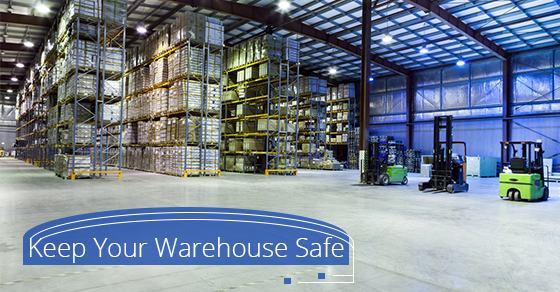A warehouse is by its very nature a risky place. Large items, moving vehicles, heavy machinery and people walking about are the ingredients for a potential catastrophe. But there are a number of things you can do to minimize the risk of injury and damage. Some of them are specific to a warehouse environment and others are more applicable to the workplace in general.
Maintaining a Safe Warehouse
The nature of warehouse works involves constant movement. Employees typically walk for long distances and are constantly bending and lifting items. Repetitive motion eventually takes its toll on the body and increases the risk of injury resulting from fatigue and pain. There are some basic safety practises that can make employees less prone to fatigue:
- Keep the employees hydrated. Let them have easy and regular access to water
- Have standard footwear that makes employees less prone to foot cramps
- Have your employees wear eye glasses if it is necessary for the job
- Wear gloves if necessary. The type of gloves to be worn depends on the nature of the work. Heavy gloves are best for handling heavy or dirty items. If employees need to use their fingers then use thin but strong gloves.
Also, have the employees trained in the safety procedures. It will take some time, but this is important to prevent costly accidents later on. They should be aware of safety signs/symbols, how to walk safely around forklifts, exit procedures and fire alarms.
It is also important to prevent warehouse hazards by having proper safety infrastructure in place. This includes guard rails, proper lighting, properly stacked materials, extension cords and outlets, clean spaces and good ventilation.
Maintaining a Safe Workplace
In addition to what has been suggested previously there are additional steps you can take:
- Keep your workspace organized. Confusion can lead to accidents, so make sure that everything is in the proper place.
- Provide written instruction and manuals that workers can refer to. This reduces any ambiguity about what should be done and how.
- Repair machinery regularly. Malfunctioning machines lower productivity and pose a safety risk to employees. Always make regular maintenance checks and repair when needed.
- Encourage employees to report any safety concerns. Employees are on the front lines when it comes to hazards. They are often the first ones to spot a problem, so encourage them to report any safety issue to management so that prompt action can be done.
- Take preventative action. It is not only important to tackle safety issues that are current and obvious, but also ones that can be a potential problem in the future.
- Foster a culture of safety. Create an environment that fosters respect for safety and get everyone involved and invested in the idea of safety.
Sometimes creating a safer workspace might involve installing new items or creating new rules. At Pentalift we can help you create a safer work space by recommending equipment that can contribute to safety or give general advice. Get in touch with us to see how we can help you create a safer environment.


